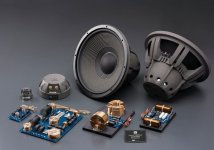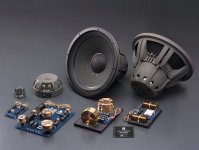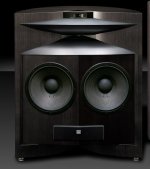Well, I've been searching all night with no luck.
Can someone post a link to a site or thread that explains the Thiele-Small parameters WITH EXAMPLES. What I mean, is there a site that explains beyond the actual definition of each parameter and tells what to look for in each parameter (good vs bad). EXAMPLE: A high Qts mean the driver will do such and such; a low Qts means the driver will be better suited for such and such, ect, ect.
Any help is much appreciated.
~Matt
Can someone post a link to a site or thread that explains the Thiele-Small parameters WITH EXAMPLES. What I mean, is there a site that explains beyond the actual definition of each parameter and tells what to look for in each parameter (good vs bad). EXAMPLE: A high Qts mean the driver will do such and such; a low Qts means the driver will be better suited for such and such, ect, ect.
Any help is much appreciated.
~Matt
I suspect that this will be way over your head, but if you want to read the original papers by Thiele and Small you can find them on my website under the 'papers' section www.readresearch.co.uk 
Thanks helped me out and found what I was looking for
In terms of examples, Morgan Jones' Arpeggio article is as good as it gets! 
We all figure out a Qts of 0.5 gives a closed box driver suitable for the Vas value of enclosure size. A driver with a Qts of 0.38 is optimal in a reflex box equal to the Vas.
What Morgan also explains is how to add resistance to a REFLEX driver to keep optimal damping in a big CLOSED box, because otherwise it is overdamped, so as to use it with a valve amp with a significant output impedance, aka low damping factor.
It's a neat trick when designing a speaker for valve amplifiers, along with impedance correction of the typical midrange impedance peak.
We all figure out a Qts of 0.5 gives a closed box driver suitable for the Vas value of enclosure size. A driver with a Qts of 0.38 is optimal in a reflex box equal to the Vas.
What Morgan also explains is how to add resistance to a REFLEX driver to keep optimal damping in a big CLOSED box, because otherwise it is overdamped, so as to use it with a valve amp with a significant output impedance, aka low damping factor.
It's a neat trick when designing a speaker for valve amplifiers, along with impedance correction of the typical midrange impedance peak.
Last edited:
Ooo-er.
Not keen on that one.
"It had to happen at some point, we’ve hit the Q word. Q is basically a describing word, it is used to describe a quality or characteristic about an electrical or mechanical part of the driver. So Qts is the overall Q of the driver, both electrical and mechanical. Qts can be thought of as how strong the motor and magnet system are. A driver with a low Qts of around 0.20 would have a large magnet and be able to move the cone with a lot of force. This makes for a tight driver. A driver with a Qts of 0.45 would have a smaller magnet and less control over its cone. So low values of Qts give a tight and punchy sound but with little weight or low bass and high Qts values give a slow and heavy sound that will give you lots of low frequency output. Watch out for drivers with really high Qts values of 0.6 or above, these would require such a big box to work correctly that in normal size boxes you don’t get much low end. They are better of being used on the rear parcel shelf of your car, where they can enjoy a massive rear chamber. "
A driver with a low Qts will need a lot of support from the cabinet in order to achieve good LF response.
Those with higher Qts can get a half-decent response on an infinite baffle, where the cabinet isn't helping the output at all.
Really high Qts drivers can be used in lossy arrangements, such as open baffles, and still hit 40Hz with little eq required.
The ratio of Qes and Qms tells you how the overall damping is made up. For modern drivers, its Qes dominated. This can make speakers quite sensitive to series resistance, which raises the Qes (thus Qts, by the way they're calculated) as the amplifier is slightly decoupled from the voice coil.
The bit about Qms I'll ignore: some say lower is better, some say higher. You can easily tell which side that particular author comes down on.
Last bit: "Drivers with a low BL value of 20 or less will be less able to control their cones. These drivers will not feel as tight as those with higher BL’s. They will also normally have higher Qts values of over 0.28 and while at home in ported or bandpass cabinets I call these drivers mud motors because of there slow and heavy sound with a less than perfect transient response."
Check the BL of a tweeter or midrange driver. Do they sound like mud to you?
I could probably go on, but I'll stop at this point as life's too short to correct the whole internet
Chris
Don't read that rubbish, it will infect your brain.
My speakers have a Qts of 0.7 and live in a 55ltr sealed box with an f3 of around 45Hz. Box Q is 0.85. I'd be more than happy to compare them to any ported speaker, to show that a box Q of 0.85 is still pretty tight and much tighter than any ported box i've heard (and i've owned plenty of ported boxes).
Qts gives you a rough idea of what type of box to put your driver in (eg sealed or ported). I've seen lower Qts drivers that have a very low fs so will still work well in a sealed box (eg the Scanspeak 21W/8555-00)
I didn't think that Page Title page was bad at all. Fs, Vas and Qts are the main practical parameters of a woofer.
Honestly; to compare the BL of a tweeter to the woofers being discussed there shows a slight lack of understanding.
Truthfully, a picture is worth a thousand words with this stuff. I have one of Morgan Jones' here:
Fatmarley's Qtc 0.85 woofer is the slightly bloated and woolly sounding yellow one, if I am following all this. Why make it complicated?
Honestly; to compare the BL of a tweeter to the woofers being discussed there shows a slight lack of understanding.
Truthfully, a picture is worth a thousand words with this stuff. I have one of Morgan Jones' here:
An externally hosted image should be here but it was not working when we last tested it.
Fatmarley's Qtc 0.85 woofer is the slightly bloated and woolly sounding yellow one, if I am following all this. Why make it complicated?
Last edited:
Fatmarley's Qtc 0.85 woofer is the slightly bloated and woolly sounding yellow one, if I am following all this. Why make it complicated?
Have you got a copy of Vance Dickasons Loudspeaker Design Cookbook? He 'chose' a Qtc of 0.92 for his LDC6 studio monitors.
Acoustic research AR18s have a Qtc of 1.0 and the bass was better than any ported speaker i'd heard prior to owning those.
A box Q of 0.55 to 0.7 maybe the best on paper but not always subjectively.
Honestly; to compare the BL of a tweeter to the woofers being discussed there shows a slight lack of understanding.
Maybe so, but my point is quite simple: you don't need such high BL values to keep control of a, say, 8" cone. In fact, I can't think of an 8" driver with a BL of >20. Are we to conclude that all 8" woofers sound like mud, as the writer would imply?
Chris
I didn't think that Page Title page was bad at all. Fs, Vas and Qts are the main practical parameters of a woofer.
Actually, Sd, Mms and (BL)2/Re are the only real physical parameters that really matter ;-)
Fs, VAS and Qts are only derived parameters, and can vary considerably due to suspension characteristics, which (fortunately) do not impact the performance of the Woofer all that much!
As a case in point, take the following two JBL Woofers (respectively used in two of their current flagship loudspeaker systems, the DD65000 and DD67000).
They are physically very similar (i.e. they share the same fundamental parameters Sd, Mms and the same magnetic motor, hence (BL)2/Re), but they use different suspensions.
Their T/S parameters are:
Woofer 1) Fs = 18 Hz, VAS = 555 L, Qts = 0.20
Woofer 2) Fs = 29 Hz, VAS = 230 L, Qts = 0.30
Do they look different enough to you?
Now go and model both in the exact same bass-reflex box (Vb = 130 L, Fb = 36 Hz)...
Surprised? ;-)
Marco
Very interesting, Marco. 
The woofers behave much the same if my rough and ready maths is correct!
But this is not surprising with reflex woofers, where the electrical motor dominates variations in mechanical suspension and mass by a 10:1 ratio at least.
In fact you can SEE that the motors are huge! I enclose my usual superlative images of the JBL DD65000 and DD67000 motor components, along with the enclosure. I do wish people put as much effort into posting as I do. We'd move along much quicker.
American speakers never fail to amaze me. Does everybody have rooms like barns?
The woofers behave much the same if my rough and ready maths is correct!
But this is not surprising with reflex woofers, where the electrical motor dominates variations in mechanical suspension and mass by a 10:1 ratio at least.
In fact you can SEE that the motors are huge! I enclose my usual superlative images of the JBL DD65000 and DD67000 motor components, along with the enclosure. I do wish people put as much effort into posting as I do. We'd move along much quicker.
American speakers never fail to amaze me. Does everybody have rooms like barns?
Attachments
- Status
- This old topic is closed. If you want to reopen this topic, contact a moderator using the "Report Post" button.
- Home
- Loudspeakers
- Multi-Way
- Thiele-Small Explained?


